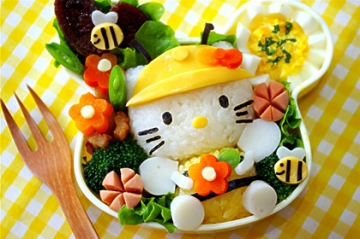
If you’ve ever been to Japan, you have probably tried some example of kawaii food. You might not have even known it, but you’ve definitely tried some of the dominant aesthetic food service. Kawaii is more than just food in Japan. You’ll find bus stops shaped like watermelon, police mascots that are more cute than scary, TV sets, fish cakes, and much more. Even construction signs shaped like frogs.
Kawaii is actually the Japanese word for “cute”. In this Asian country, Kawaii has so many interpretations. But in the past 10 to 15 years, Kawaii food has taken over.
Contrary to popular opinion, kawaii is not about perfection. Speak to any product designers, fashion luminaries, event organizers, manga artists, food experts, food bloggers, and they will all tell you that perfection is obsolete. Kawaii products need to be “cute, not too cute”. If they are too cute, they won’t sell.
Kawaii food, and kawaii products are generally associated with a roundness of composition, pastel colors, and childlike facial proportions. However, aesthetic perfection is undesirable. If the characters are too perfect, consumers are suspicious. They do not purchase them, and they think of them as childlike. Kawaii is more than just food for children.
Another popular misconception is that kawaii is sexy. In the world of fashion, kawaii is something ideal. Girls want to be “kawaii”. But that is not pretty, sexy, or even glamorous. Japanese girls want to be called “kawaii”, which means they are cute, innocent, endearing, and sweet. To foreigners it seems like kawaii means so many different things. And it is understandable. People in Japan use the word kawaii for almost everything. But it is all to symbolize something cute and adorable.
Hello Kitty is the most famous example of kawaii food. The popular kitten has made it into every industry, from fashion to culinary. But there are many other examples.
For example, Kirimi-chan is a delicious salmon fillet. Walking and talking animals are normal in Japan, and Kirimi-chan is just one example. The salmon even gets on Twitter to say “Please eat me, I’m delicious”.
Anpanman is the classic superhero, the granddaddy of modern food characters. Anpanman is a bread roll with sweat bean paste inside, and he wears a cape. He never gets stale. Anpanman is one of the first examples of kawaii food. He first appeared as a manga in 1973, and changed Japanese cooking since then.
Nowadays, almost any food can be made into a character. You can find fruits and vegetables that come to life thanks to a face, arms, and legs. Food character designers often go beyond giving the fruits and veggies just a face. They even combine different fruits and veggies. Food fusion is another popular trend in Asian countries. There are so many ways to combine food. And the simple rule is: cute, but not too cute.
The rise of cuteness and kawaii culture emerged in the 1970s, as mentioned previously. And kawaii spread to different areas of Japanese lifestyle. Teenage girls began to write literally with mechanical pencils. And that allowed girls to produce fine lines, which were different than the traditional Japanese writing lines.
The writing caused controversy, and was banned in many schools. However, in the 1980s, kawaii writing was adopted by magazines and comics.
Kawaii food, and kawaii cooking has gone from Japan, to many other parts of the world. The Western culture has adopted the cute and adorable trend as well. That has allowed many bloggers from Japan and all around the world to earn money by cooking in kawaii.
People use miniature stoves and cooking utensils as prime assets to create adorably tiny dishes. You can find many mini edible dishes, with sushi being the most common dish.
But do not worry. You can find cooking recipes for big meals as well. Making food taste delicious is not enough anymore. You need to make food look good as well, and some bloggers can help with that. Some examples include this, this, this, this, and this one.

The UK is divided both geographically and trend wise when it comes to sneakers (trainers). In the north football culture reigns supreme, while London is inspired by hip-hop and gri...
Finn's Law is a piece of legislation in the United Kingdom that provides greater protection to service animals, such as police dogs and horses.The law is named after a police dog n...
"The Only Son" is a 2013 Dutch documentary, directed by Simonka de Jong. It is a story about the challenge of keeping Dolpo’s ancient culture alive as the area becomes less isola...
The Akha in Laos live almost untouched by modern civilization. They still adhere to their archaic customs. But they are on the verge of upheaval.Cut off from the rest of the world,...